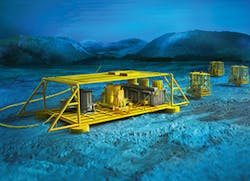Offshore staff
TRONDHEIM, Norway – Siemens has finished the first phase shallow-water test of its Subsea Power Grid in Trondheim, mid-Norway.
The company, in collaboration with Chevron, Equinor, ExxonMobil, and Eni Norge, is in the final stages of a program of developing what it claims will become the world’s first seafloor power grid designed for distribution of medium voltage power using pressure-compensated technology.
“There will be more subsea compressors, pumps, processing plants, and in the future entire production facilities placed on the seabed, all of which require power,” said Frode Tobiassen, Head of Subsea at Siemens.
The Subsea Power Grid facilities comprise a subsea transformer, subsea switchgear, subsea variable-speed drive, subsea wet mate connectors, and a remote control and monitoring system that includes cloud-based user dashboards and data analytics.
According to Siemens, the technology will enable subsea processing with multiple seabed power consumers. Potential applications include support for enhanced recovery in subsea brownfield projects and tiebacks, with single- or multi-phase boosting to increase oil recovery.
During the initial test phase at Siemens’ test site in Trondheim, the system operated in a ring loop topology at full load and a test/verification program was run. Initial test results were positive with all components operating within their design parameters.
The next phase will involve an extended shallow-water test to build operational experience and verify long-term reliability. Siemens’ goal is to accumulate 3,000 hours of runtime on the equipment while undertaking further tests.
In parallel, preparations are progressing for a deepwater pilot program under which the equipment will be installed and used on a subsea field.
11/09/2018



